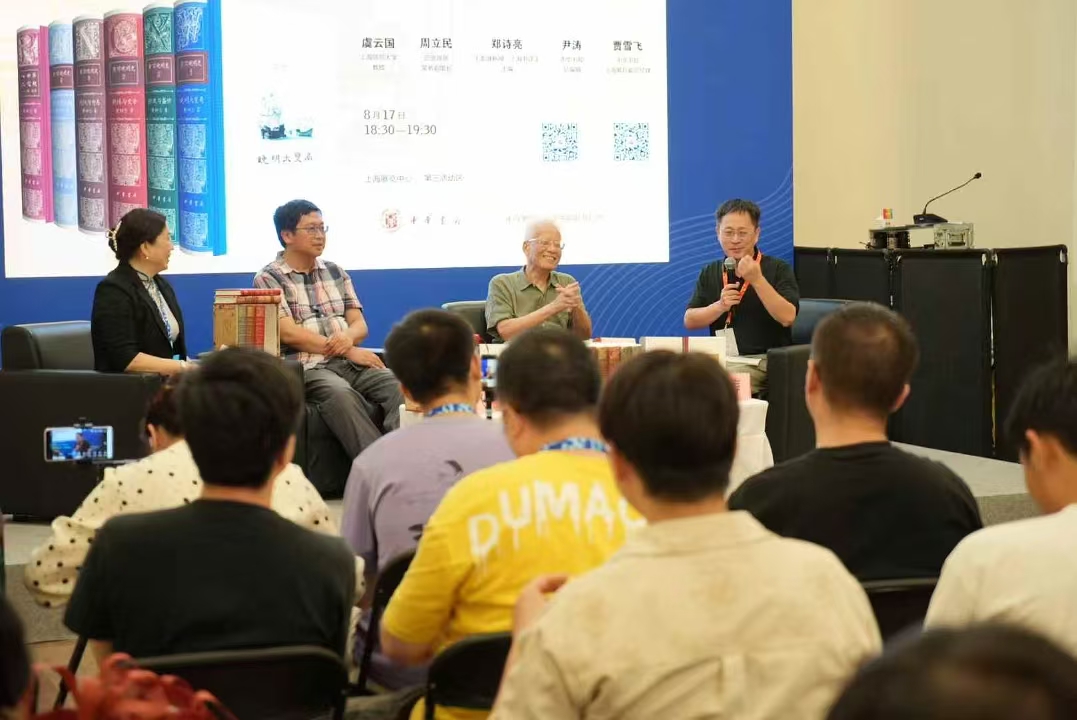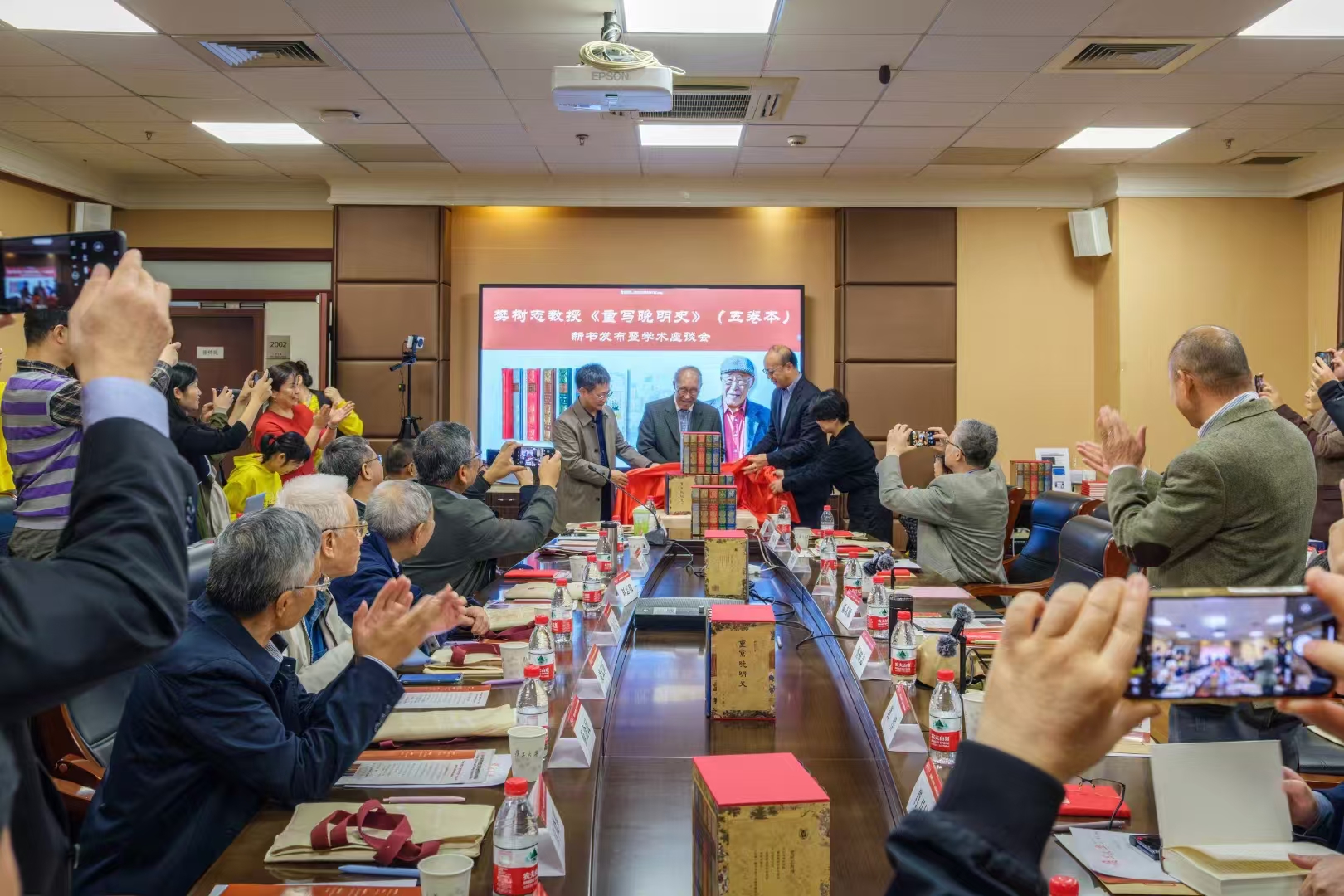
Tranalysis
On August 17, 2024, Professor Fan Shuzhi's five-volume "Rewriting the History of the Late Ming Dynasty" was met with readers at the Shanghai Book Fair. The response was enthusiastic, and many readers from other places came to the book fair for this purpose; On November 3, 2024, the Department of History of Fudan University and Zhonghua Publishing Company jointly held the "New Book Release and Academic Symposium on Fan Shuzhi's" Rewriting the History of the Late Ming Dynasty ". More than 30 guests from all over the country gathered to enthusiastically discuss Professor Fan Shuzhi's academic research and the publishing value of" Rewriting the History of the Late Ming Dynasty ". As a student of Professor Fan Shuzhi and the responsible editor of "Rewriting the History of the Late Ming Dynasty", I am moved and shocked, and once again express my greatest respect for Mr. Fan Shuzhi and his research!

Shanghai Book Fair "Rewriting Late Ming History" Readers Meeting Event

New book release and academic symposium
1. Three academic changes, achieving development amid twists and turns
Professor Fan Shuzhi was the first batch of historians trained in New China. Since he stayed in school as a teacher in 1962, it can be said that his more than 60 years of academic experience have simultaneously reflected the country's more than 70 years of tortuous but glorious development history.
From staying in school to studying economic history in the 1990s. Professor Fan Shuzhi's undergraduate thesis is titled water transport. In 1962, his thesis "A Brief Introduction to Water Transport in the Ming and Qing Dynasties" published in Academic Monthly was part of his undergraduate thesis and was also his academic "toddler" recognized by Professor Chen Zhushi. However, from the 1950s to the early 1970s, political movements continued, and scholars devoted extremely limited time to research. After the college entrance examination resumed in 1977, he wrote detailed lectures to teach undergraduate students the course "History of Land Relations in China", and then spent several years revising and enriching it into a 500,000-word "History of the Development of Feudal Land Relations in China." At the same time, with the opening of the country, the study of economic development, especially the economy of Jiangnan in the Ming and Qing Dynasties, has become a hot topic in the academic world. Having accumulated research on economic history, he invested in the study of Jiangnan towns in the Ming and Qing Dynasties in 1981. Based on a large number of documents and on-the-spot research, through case studies of multiple towns, he keenly observed the human, technological, trade and social and economic changes behind the economic development of Jiangnan towns in the Ming and Qing Dynasties, and wrote "Exploration of Jiangnan Cities in the Ming and Qing Dynasties". Later, it was enriched and improved into more than 500,000 words "Jiangnan Town: Traditional Transformation".
Professor Fan Shuzhi once said that he "really became a scholar when he was fifty years old." This is his modest words, which means that learning is getting better. Professor Fan Shuzhi, born in 1937, was fifty years old, that is, after entering the 1990s. At this time, marked by the writing of "Wanli Biography" and "Chongzhen Biography", he began to move into the research and writing of political history in the late Ming Dynasty. During this period, the peak of his academic research was "History of the Late Ming Dynasty (1573-1644)" published in 2003. In the 20 to 30 years before and after the turn of the century, with the continuous deepening of China's reform and opening up and the increasingly frequent exchanges with the world, the academic community has also simultaneously shown unprecedented prosperity and ideological activity. At that time, the research of scholars such as Yi Maoke, Huang Zongzhi, and Huang Renyu, as well as various Western historical research works represented by the Annals School, were introduced, translated and published in China. This allowed domestic scholars to broaden their horizons and be deeply influenced by new research. Inspired by the perspective, we began to formulate research on China history based on our own academic background and based on global development. It can be said that this period is not only the research background of Professor Fan Shuzhi at this stage, but also the realistic foundation of his rich and mature self-research system. On the one hand, he achieved self-breakthrough in the research direction of Jiangnan economic history and completed "Jiangnan Cities and Towns: Traditional Transformation". On the other hand, he completed the 800,000-word "Late Ming History (1573-1644)".
From June 28, 2004, when he wrote an article in Jiefang Daily, when he first publicly proposed the idea of "Great Changes in History in the Late Ming Dynasty", to the publication of "Great Changes in the Late Ming Dynasty" in 2015, it was another breakthrough for him academically. and overall improvement of the pattern. As Professor Tang Lixing commented, Professor Fan Shuzhi has "always been a leader at the academic forefront." Whether he put forward the new academic conclusion of "great changes in history in the late Ming Dynasty" in 2004, or saw traditional changes in his research on Jiangnan towns in 2005, his profound academic foundation, broad academic vision and concern for society. The scholarly awareness of people's livelihood has always kept him a kind of scholar's acumen and forward-looking. The twenty years that have entered the 21st century are two decades in which my country's economy has taken off at a high speed and society has developed overtaking. They are also two decades in which Chinese people's cultural confidence has become high and mature, and science and technology have been elevated to par with the international high level. In 2024, when human society was wandering at the crossroads of world historical changes, Professor Fan Shuzhi used the five-volume "Rewriting the History of the Late Ming Dynasty" to present the historical opportunities that China faced and the historical lessons of missed development during the late Ming Dynasty. I believe that readers will have different opinions and will use the light of history to illuminate our way forward and stake our path to success in the ever-changing world historical changes.

The author of this article (first from right) and Professor Fan Shuzhi (middle)
2. Pioneering through opening up and embracing others to create a broad international academic vision
From reform and opening up to the turn of the century, with the increasingly close exchanges between international academic circles and the explosive influx of fruitful international academic achievements, domestic scholars began to reflect on academic research from the aspects of problem awareness, conceptual terms, methodological logic, theoretical construction, etc., and With a down-to-earth pursuit and a spirit of seeking truth from facts, it promoted the prosperous era of social and economic history research. Professor Fan Shuzhi, who was completely and deeply involved in this historical process, formed his own academic spirit of "openness and pioneering" in this process.
Since the 1980s, as a professor in the Department of History at Fudan University, Fan Shuzhi has frequently participated in interactions, mutual visits, and cooperative research with international scholars. For example, in the early 1980s, he received many visits from Masao Mori, a professor at Nagoya University in Japan, to Fudan University; in 1983, within six months of Masao Mori's long-term visit to Fudan University, they and Professor Wu Dango organized a three-person research meeting to regularly discuss the issue of official land and civilian land in Jiangnan of the Ming Dynasty; From June to December 1986, he visited Kansai University in Japan as an exchange scholar. During this period, he was invited to give academic lectures at the University of Tokyo, Osaka University, Nagoya University, and Kyushu University, and participated in the "Ming and Qing Class" of the Institute of Humanities, Kyoto University. Seminar activities, etc.
It is precisely because Professor Fan Shuzhi has had a broad academic vision since the beginning of his serious academic studies that since the book "Exploration of Jiangnan Cities and Towns in the Ming and Qing Dynasties" in 1987, his works have been characterized by solid historical materials and an open international perspective., well-known in the academic world. As Professor Huang Jingbin commented,"Exploration of Jiangnan Cities and Towns in the Ming and Qing Dynasties""early broke out of the problem consciousness of change in production relations and 'development or stagnation', and focused on rural urbanization (urbanization), regional and domestic market networks. The structure and function of the demonstration have been taken as the focus, thus truly realizing the transformation of the awareness of issues and research ideas in the economic history of the Ming and Qing Dynasties." "This is inseparable from his active study and absorption of the theories and methods of foreign research on China history, so he opened his horizons early in his research and established an international academic vision."
"The Great Changes in the Late Ming Dynasty" published in 2015 is a representative work of Professor Fan Shuzhi's international academic vision. In the book, he identifies, draws on, absorbs and integrates the latest achievements of international academic circles, and puts forward new academic conclusions. It is the book Guangzheng Bo quoted the writings of European, American and Japanese academic circles in recent years, reviewed and analyzed, and discussed and proved the great historical changes that occurred in the late Ming Dynasty from six aspects-"the breakthrough of the 'sea prohibition-tribute' system" and "the involvement of globalization. The wave of trade","Jiangnan towns: prosperity of multi-level commodity markets","The trend of ideological liberation","The spread of Western learning eastward and the advanced China people looking at the world", and "New atmosphere: literati associations and speeches". From the perspective of global history, the book places the late Ming society for discussion in the process of world history, arousing unanimous attention and long-term discussions among academic circles and Chinese people.
In October 2024, Professor Fan Shuzhi said in an interview with the media on the five-volume "Rewriting the History of the Late Ming Dynasty":"From the end of the 15th century to the beginning of the 16th century, European navigators discovered new routes to the East and discovered the new continent of America. Human history entered a new era and became a turning point between the Middle Ages and modern times in Europe. Previously, in the eyes of Europeans, world economic history was centered on China. In this sense, the modernization of China and Europe is almost synchronized, or it can be said that the late Ming Dynasty was the beginning of China's modernization." "In the late Ming Dynasty from the 16th to 17th centuries, great changes took place in all aspects of economy, society, culture, and thought, and new phenomena, new factors, and new breakthroughs emerged. In a word, modernization was beginning to emerge." Professor Fan Shuzhi, in the year of Mishou, put China in the late Ming Dynasty into the developing world and recounted the new scenes in trade, culture, and thought that emerged in the late Ming Dynasty. "China's modernization started almost at the same time as Europe, but it struggled for various reasons, mixed with stagnation and even retrogression, and gradually fell out of date." He said earnestly, trying to present history as truthfully as possible and inspire future generations to think."This may be the meaning of historical research."
3. Practice it and pay tribute to the grand narrative
For Professor Fan Shuzhi's five-volume "Rewriting the History of the Late Ming Dynasty", the reader's most intuitive feeling is the vast and powerful narrative-more than 2.3 million words and five-volume length, which covers the period from the middle of Jiajing to the collapse of the small court in the Southern Ming Dynasty. More than a hundred years of history.
Readers familiar with the study of late Ming history know that unlike scholars such as Li Wenzhi and Xie Guozhen who study the late Ming Dynasty, Professor Fan Shuzhi defined "late Ming" as 1573-1644, that is, from the first year of Wanli to the 17th year of Chongzhen. In his own words, this choice is for ease of research and for the logic of the development of modern world history. However, in "Rewriting the History of the Late Ming Dynasty", the historical period covered by it extends for thirty years based on the original definition of "Late Ming Dynasty". In order to clarify the background of Zhang Juzheng's determination to carry out official governance and economic reforms in the early years of Wanli, the full text starts with the cabinet struggles and iterations in the middle of Jiajing, giving readers a comprehensive understanding of the bloody political background of the New Deal reform and how Zhang Juzheng transformed from a hot-blooded youth to a resourceful politician; The end of the book takes the life of Wu Meicun, a Jiangnan celebrity who wrote the famous line "The anger becomes a beauty" as the starting point. He follows his experiences and horizons to see the changes of world affairs and the people of the world in the late Ming and early Qing Dynasties. The sad aftertaste of "watching him build a Zhu Tower, watching him entertain guests, and watching his building collapse" ends the book, inspiring readers to think endlessly about the history of the late Ming Dynasty and even the entire human history.
"With the accumulation of academics, scholars should continue to break through themselves," Professor Fan Shuzhi said. From "Exploration of Jiangnan Cities and Towns in the Ming and Qing Dynasties" to "Jiangnan Cities and Towns: Traditional Transformation" to "Early Urbanization of Jiangnan Cities and Towns", from "History of the Late Ming Dynasty" to "Rewriting the History of the Late Ming Dynasty", Professor Fan Shuzhi has been constantly realizing the breakthrough of oneself, constantly breaking through the "ceiling", and carrying out academic research to the highest level.
While constantly achieving self-academic breakthroughs, another thing that Professor Fan Shuzhi is thinking about is the hope that young scholars can break through the cage of fragmented research. He once borrowed the common problems of today's researchers pointed out in the "History Manifesto"-increasingly limited to professional and fragmented research, increasingly narrow and unaware of long-term grand narratives-to express his concern about today's fragmented research: because fragmented research is too trivial and remote, it gradually becomes self-explanatory and cannot cause controversy on academic platforms. He would like to pay tribute to the historical research of grand narratives with "Rewriting the History of the Late Ming Dynasty."
"Rewriting the History of the Late Ming Dynasty" is indeed a historical model of grand narratives. Under the introduction "The Great Changes in the Late Ming Dynasty", the book is divided into four volumes in chronological order to show the New Deal reforms ("New Deal and Prosperity") and the Tianqi Dynasty. The disaster of party strife ("Court and Party Struggle"), and the period from internal and external troubles to the collapse of the Chongzhen Dynasty ("Internal Worries and External Aggression" and "The End of the Dynasty"), the depth of history and the extension of the times are enough to support grand historical scenes; at the same time, the book accommodates research fields such as economic history, political history, institutional history, cultural history, academic thought history, history of cultural exchanges between China and the West, and involves hundreds of core reference documents such as various historical books, anthologies, local chronicles, notes, and research works. The breadth of the field and the rich historical materials fill the grand narrative with rich details and vivid scenes.
After being over eighty years old, Professor Fan Shuzhi completed the masterpiece of more than two million words "Rewriting the History of the Late Ming Dynasty" by himself. His unremitting efforts in academic research, he integrated academia into his life, making everyone who knew him respect him. He maintained strong brain power and continuous physical strength in his eighty years, which made everyone who knew him envious-"constantly break through oneself" and "life without limits". Professor Fan Shuzhi did it. Isn't this a great inspiration he gave us?
Finally, I end this article with a short story.
In recent interviews and academic seminars, many media have noticed the saying that Professor Fan Shuzhi once said that "work is the best way to maintain health." The source of this sentence was on the banks of the Qinhuai River on April 29, 2016. On the same day, my junior sister and I accompanied Teacher Fan to Nanjing to give an academic lecture on "The Great Changes in the Late Ming Dynasty." After arriving in Nanjing in the afternoon, we took a break from our busy schedule and went to Confucius Temple to reminisce about the past. After coming out, we sat by the river and chatted. Talking about many readers asking Teacher Fan the secret of "health preservation". Teacher Fan laughed: Where do I have health preservation?! For me, work is the best health. My junior sister and I laughed too. I took a photo of Teacher Fan still smiling and sent it to a circle of friends: Teacher Fan said that work is the best way to maintain health.

Fan Shuzhi, a professor at Fudan University, is committed to the study of Ming history and the economic history of the Ming and Qing Dynasties. Representative works include: "Rewriting the History of the Late Ming Dynasty","Early Urbanization of Jiangnan Cities and Towns","Twelve Lectures on the History of the Ming Dynasty","Graphic History of China","Sixteen Lectures on National History","Zhuan of Chongzhen" and "Zhuan of Wanli", etc.
